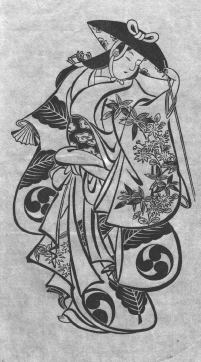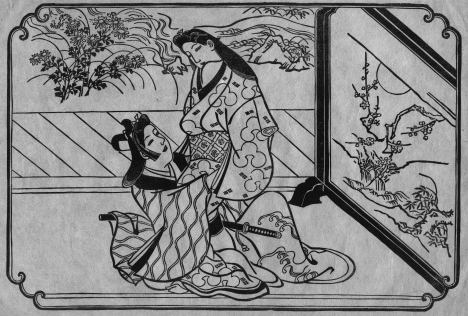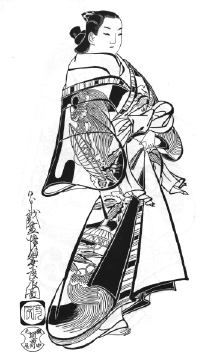Seditious Beauty (entry by David Bull)
In the early 1600's, when Ieyasu, the founder of the Tokugawa dynasty, finally achieved his dream of becoming shogun, the grand military ruler of all Japan, he immediately started to set up an intricate and complex arrangement of rules designed to govern the behaviour of all inhabitants of the country. His motivation was very clear, the restriction of social mobility, the preservation of the status quo, and thus the prolongation of his (and his descendants) position as rulers of the nation for as long as possible. From quite some time before this, Japanese society had been stratified into horizontal layers, with everybody's position on the scale made very clear, from the figurehead status of the emperor at the top, down through nobility, warriors, farmers, artisans, merchants, and so on, right down to the absolute bottom, the outcasts, but this was now codified and set in concrete. Almost every possible aspect of life was regulated - what fabrics and patterns of clothing were permitted to each class, what types of house could be built, to what extent people could travel, communication with people of other classes, and of course what kind of daily activities were allowed. Ieyasu's prescription for maintaining power turned out to be extremely effective. For over two and a half centuries (1603-1868) his family reigned over the country, an enormously long time, especially when compared with the wars and chaos ravaging Europe during the same period.
 But rules were only rules, and reality was something
different entirely. Although the concept worked very well for the
first hundred years or so (at least from the Tokugawa family's point
of view), it was impossible to 'stop the clock' completely in actual
practice, and strains gradually appeared in the system. One of the
biggest problems concerned money. The warrior class had traditionally
been compensated for their services in rice, rather than with actual
negotiable currency. The allotment of rice they received served to
support their family and retainers, and this was adequate as long as
they maintained an exclusively traditional lifestyle. But gradually
arising in the cities, especially in Edo (old Tokyo), was a new
lifestyle, one being led by a newly enriched merchant class, and in
which money played an ever-increasing role. The men of this
mercantile class were poor in status, standing very low in the social
hierarchy, but were increasingly rich in actual cash, obtained
through their manufacturing or trading activities.
But rules were only rules, and reality was something
different entirely. Although the concept worked very well for the
first hundred years or so (at least from the Tokugawa family's point
of view), it was impossible to 'stop the clock' completely in actual
practice, and strains gradually appeared in the system. One of the
biggest problems concerned money. The warrior class had traditionally
been compensated for their services in rice, rather than with actual
negotiable currency. The allotment of rice they received served to
support their family and retainers, and this was adequate as long as
they maintained an exclusively traditional lifestyle. But gradually
arising in the cities, especially in Edo (old Tokyo), was a new
lifestyle, one being led by a newly enriched merchant class, and in
which money played an ever-increasing role. The men of this
mercantile class were poor in status, standing very low in the social
hierarchy, but were increasingly rich in actual cash, obtained
through their manufacturing or trading activities.
With increasing amounts of money on hand, and expanding amounts of leisure time available, it was inevitable that new forms of social activity would arise, and this period saw the development of two institutions that would help to transform large parts of society, and contribute greatly to the eventual breakup of the feudal class system; the kabuki theater and the 'Yoshiwara', the red-light district. Not coincidentally, the art that we now know as Ukiyo-e had a significant role to play in both of these.
Although the origins of the kabuki theater lie many years before the Tokugawa era, it could not flower until these necessary circumstances arose. It became hugely popular, attracting not only townsmen and merchants, but also, much to the displeasure of the rulers, members of the samurai class. Woodblock prints played an important part in the life of the theater, not just as 'advertisements' for the actors and productions, but as an integral part of the experience of visiting the theater. In an era with no television or newspapers, they performed the essential function of disseminating the theatrical experience to an audience far wider than simply those people who attended the productions. The problem, from the point of view of the authorities, was that the plays invariably moved into areas where the subject matter was at variance with the 'official' line, and there was constant friction between the theaters and those wishing to proscribe their activities. The woodblock prints were not excepted from these battles, and all designs had to obtain the censor's approval before production. Despite this pressure to conform, the prints continued to be a contributing factor to social change, and even such a famous designer as Utamaro spent a term imprisoned for producing material considered to be critical of the shogun.
Although on a far more 'private' scale than the noisy theater, with most of its activities taking place in seclusion, the Yoshiwara was perhaps a more vital agent of social change. Sometimes referred to nowadays as the 'green houses', the brothels there provided far more than simple sexual services. They were places for townsmen to meet, to spend leisure time, to discuss affairs of the day, and of course to make romantic assignations. Unlike the image of similar European institutions of the time, where one can imagine revolution being plotted under the noses of the king's agents, the Edo townsmen were not concerned with overthrowing the government. But their pursuit of basically hedonistic activities, including poetry readings, discussions of recent novels, showing off recent acquisitions of new clothing or the like, served to undermine the stated goal of the regime to keep 'everyone in his place'. And ... they started to attract men from the warrior class.

